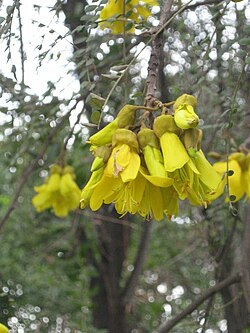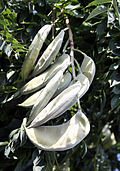Fabaceae
Fabaceae is the systematic name of the plant family that is commonly known as the Pea family. It consists of three subgroups: Caesalpinioideae, Mimosoideae and Papilionoideae (or better Faboideae). In modern systems like APG II this family Fabaceae is closely related to Quillajaceae, Polygalaceae or milkworts (including the families Diclidantheraceae, Moutabeaceae, and Xanthophyllaceae), and Surianaceae.
| Pea family | |
|---|---|

| |
| Sophora cassioides | |
| Scientific classification | |
| Kingdom: | |
| Division: | |
| Class: | |
| Order: | |
| Family: | Fabaceae Lindl. (1836)
|
| subfamilia | |
|
Caesalpinioideae | |
Description
The leaves are usually alternate and compound, in the Mimosoideae and the Caesalpinioideae commonly bipinnate (e.g. Acacia, Mimosa). In many species the leaves have structures evolved to attract ants, that, being predatory, protect the plant from herbivore insects. Extrafloral nectaries -a gland secreting nectar -are common among the Mimosoideae and the Caesalpinioideae and are also found in some Faboideae (e.g. vetches Vicia sativa). Fabaceae are typically entomophilous plants (i.e. they are pollinated by insects) and the flower are usually showy to attract the pollinators.
In the Mimosoideae the flowers are radial symmetric or actinomorphic. In the Caesalpinioideae and Faboideae (see diagram) are most often zygomorphic or bilateral in simmetry.
| |||||||||||||
Fabaceae Media
The fruit of Gymnocladus dioicus
Roots of Vicia with white root nodules visible
Cross-section through a root nodule of Vicia observed through a microscope
Indigo colorant
The cockspur coral tree Erythrina crista-galli is one of many Fabaceae used as ornamental plants. In addition, it is the national flower of Argentina and Uruguay.
Acacia baileyana (wattle)
Calliandra emarginata
Cassia leptophylla tree
Related pages
Other websites
| Wikimedia Commons has media related to Lua error in Module:Commons_link at line 62: attempt to index field 'wikibase' (a nil value).. |
- List of genera Archived 2007-09-26 at the Wayback Machine











